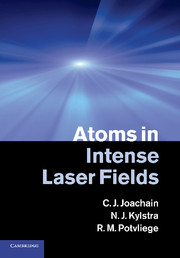Book contents
- Frontmatter
- Contents
- Preface
- Part I Basic concepts
- Part II Theoretical methods
- 3 Perturbation theory
- 4 Floquet theory
- 5 Numerical integration of the wave equations
- 6 The low-frequency regime
- 7 The high-frequency regime
- Part III Multiphoton atomic physics
- Appendix: Atomic units and conversion factors
- Author index
- Subject index
- References
4 - Floquet theory
Published online by Cambridge University Press: 05 January 2012
- Frontmatter
- Contents
- Preface
- Part I Basic concepts
- Part II Theoretical methods
- 3 Perturbation theory
- 4 Floquet theory
- 5 Numerical integration of the wave equations
- 6 The low-frequency regime
- 7 The high-frequency regime
- Part III Multiphoton atomic physics
- Appendix: Atomic units and conversion factors
- Author index
- Subject index
- References
Summary
In this chapter,we shall analyze the particular case of an atom interacting with a laser pulse whose duration is sufficiently long, so that the evolution of the atom in the laser field is adiabatic. When this condition is fulfilled, the atom can be considered to interact with a monochromatic laser field. As a consequence, the Hamiltonian of the system is periodic in time, and the Floquet theory [1] can be used to solve the time-dependent Schrödinger equation (TDSE) non-perturbatively.
We begin in Section 4.1 by considering the Hermitian Floquet theory. We first derive the Floquet theorem for a monochromatic, spatially homogeneous laser field and show that the solutions of the TDSE correspond to dressed states having real quasi-energies, which can be obtained by solving an infinite system of time-independent coupled equations. We then generalize the Floquet theory to multicolor laser fields and to “non-dipole” laser fields which are not spatially homogeneous. In Section 4.2, the Floquet theory is applied to study the dynamics of a model atom having M discrete levels interacting with a monochromatic laser field. In this case, the coupling between the bound and continuum atomic states is neglected.We analyze the relationship between the Floquet theory and the rotating wave approximation, and examine the perturbative limit of the Floquet theory. We also consider the population transfer between Floquet dressed states.
- Type
- Chapter
- Information
- Atoms in Intense Laser Fields , pp. 141 - 217Publisher: Cambridge University PressPrint publication year: 2011



